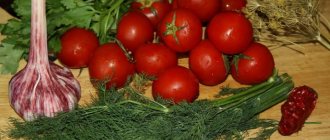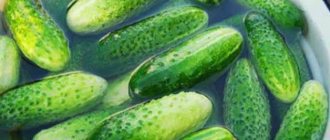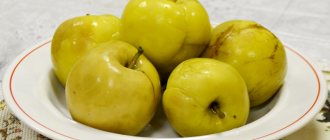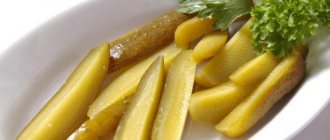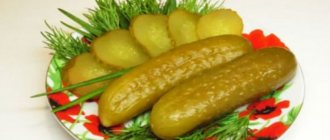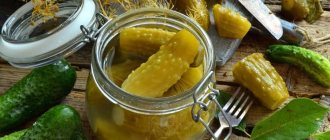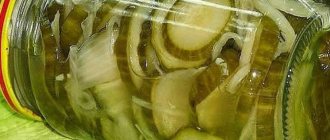How to ferment cucumbers in a barrel
Each housewife carefully keeps her secrets of preparing this traditional dish. Depending on the desired result, you can get cucumbers with a dense structure, as well as tender and crunchy vegetables. Strict adherence to all recipe instructions is a guarantee of an excellent finished dish.
First you need to choose the right cucumbers. For pickling, it is best to use specimens freshly picked from the garden. However, given the large amount of the required starting product, you can take vegetables that are 3-4 days fresh. Almost all varieties of plants whose pimples have black dots are suitable for pickling.
Important! In order for pickled cucumbers to be evenly salted, it is necessary to use fruits of the same size in each individual barrel.
A mandatory procedure before fermentation is pre-soaking in cold water. This guarantees that the dish will receive additional crunch in the future, and also eliminates possible bitterness. Cucumbers are placed in a large container with water for 4-6 hours. The liquid should be as cold as possible. If desired, you can add a little ice to it.
Another important ingredient when preparing pickled barrel vegetables is salt. To ensure the correct percentage of its content in the finished snack, it is best to use a large stone one. “Extra” salt is not suitable due to its too fine structure. You should also refrain from iodized and sea water - they activate fermentation processes.
Attention! Depending on the size of the cucumbers, the amount of salt per 1 liter of water changes. For small vegetables the dose is 60-70 g, for larger vegetables - 80-90 g.
The most creative part of preparing pickled cucumbers is the use of a variety of spices and additives. Depending on additional ingredients, the taste of the finished product can change dramatically. Many housewives use dill, garlic, thyme and tarragon for fermentation. Currant and cherry leaves are actively used. One of the most popular additives is horseradish root and shoots - they make the brine cleaner and protect it from possible mold.
Is it possible to ferment overgrown cucumbers in a barrel?
Fruits of almost any degree of maturity are suitable for pickling. Even if the cucumbers have grown too large and have thick skins, you can still get a great finished product. It is best to ferment large specimens together - this will guarantee uniform salting.
Important! If the fruits are already covered with a dry yellowish peel, it is better to refrain from using them. Such a skin will not allow the required amount of salt to pass through.
As with regular cucumbers, overgrown cucumbers are prepared according to almost the same recipe. The only difference is a slightly larger amount of salt used and an increased cooking time. Due to their appearance, large fruits that are ready to be fermented in a barrel are not served whole, but are cut into several parts.
Is it possible to ferment cucumbers in a plastic barrel or bucket?
If it is not possible to use traditional wooden barrels, you can make do with easily accessible plastic containers or stainless steel buckets. Such containers can guarantee the absence of foreign odors and tastes in the finished product. In addition, you can use containers of the required volume depending on the initial amount of product.
Plastic barrels, metal buckets and their lids must be prepared before pickling cucumbers. To do this, they are washed twice with a soda solution. Afterwards they need to be scalded with boiling water and wiped dry.
Preparing a barrel for fermentation
A barrel is the most popular container for preparing pickled cucumbers. Oak is best suited for recipes - it contains special compounds that act as preservatives and also prevent the formation and spread of mold. If you don’t have an oak barrel, you can use a linden one.
Important! Experts in making homemade pickles do not recommend cooking in aspen and pine containers - they can transfer foreign flavors to the finished product.
Before you start harvesting, it is important to properly prepare the container. If the barrel has not been used before, then it is necessary to remove tannins from its walls, which can spoil the taste of pickled cucumbers. If the container has been previously used for preparing pickles, it is necessary to thoroughly clean it of traces of previous use. Traditionally, there are 3 stages of preparing barrels - soaking, washing and steaming.
Soaking new wooden utensils takes 2-3 weeks. The water needs to be changed every couple of days to avoid a musty smell. As soon as it stops being painted in darker tones, you can proceed to the next stage. For previously used barrels, a different method is used - water with bleach dissolved in it is poured into them for an hour.
After the soaking procedure, the pickling containers must be thoroughly washed. In addition to running water, you can use a light solution of soda - it perfectly helps fight dirt. For more thorough washing, iron brushes are used - they allow you to remove even stubborn food residues.
Steaming cucumbers before pickling is analogous to traditional sterilization. To do this, place wormwood, juniper, and mint at the bottom of the container and pour several buckets of boiling water over them. The barrel is tightly closed with a lid and left until the water cools completely.
How to properly store pickles
You can store the product directly in the bucket in which fermentation occurs, but only on condition that the container is located in a cool and dark place (cellar, basement, refrigerator). If this is not possible, it is best to put crispy vegetables in jars and roll them up.
This can be done only after the fermentation process is completed, which depends on the type of pickling: cold-salted greens ferment for 30–45 days, hot-salted greens for 7–10 days. The olive color of the peel will indicate the vegetables are ready.
Rolling up salted greens consists of the following points:
- Drain the brine and strain it through a sieve or cheesecloth (three times).
- Rinsing greens and herbs under clean running water to remove white deposits.
- Washing jars in water and soda.
- Putting washed herbs and spices into jars (it is also recommended to transfer and cover vegetables on top).
- Putting cucumbers in a jar.
- Boil the brine and pour pickles over it for 20 minutes. Then the brine is drained and boiled a second time. The procedure is repeated again after 15 minutes. During the boiling process, a white foam will form on the brine; it must be collected using a slotted spoon.
- The greens drenched in brine are rolled up with sterile lids, wrapped and left to cool completely.
Did you know? Cucumbers were widely used by the ancient Greeks for medicinal purposes. They were believed to be able to reduce fever.
Pickled cucumbers rolled into jars can be stored even in apartment conditions, at room temperature.
Traditional recipe for cucumbers pickled in a barrel
The simplest method of preparing vegetables for the winter uses a minimum set of ingredients. Pickled cucumbers turn out very tasty and crispy, and the absence of additional spices allows you to enjoy the pure taste of the product. To prepare the snack use:
- 50 kg of medium-sized cucumbers;
- 3.5 kg of coarse salt;
- 1 kg dill;
- 5 liters of water.
Dill greens are divided into 2 equal parts. One of them is placed at the bottom of the barrel. Half of the cucumbers are placed on top of it. They are sprinkled with the remaining dill, after which the second part of the vegetables is laid out. Cucumbers are poured with saline solution and left for 2-3 days at room temperature. As soon as the process of active fermentation begins, the barrel is sealed and put away for a month in a cold room, the temperature in which varies from 1 to 3 degrees.
Is it possible to pickle cucumbers in a plastic bucket?
Many housewives advise using special containers for preparing winter pickles. The most suitable are enameled iron buckets, in which the pickles are very tasty and aromatic. However, sometimes people do not have the opportunity to use such utensils and have to salt in a plastic bucket.
Some people believe that containers made of plastic negatively affect the taste of pickles, but this is not the case.
Vegetables pickled in a plastic bucket are no different from pickles prepared in enamel buckets.
How to ferment cucumbers for the winter in a barrel with horseradish and currant leaves
Barrel pickled vegetables according to this recipe turn out incredibly juicy and crispy. The horseradish leaves give them a slight piquancy, and the currants add a wonderful aroma. To prepare barrel cucumbers according to this recipe you need:
- 100 kg of main ingredient;
- 6-7 kg of table salt;
- 1 kg of currant leaves;
- 1 kg of horseradish leaves;
- 10 liters of liquid.
Some of the greenery is placed at the bottom of the oak barrel. Half of the previously soaked cucumbers are placed on top of it. Then another layer of crushed currant and horseradish leaves is laid out, after which the remainder of the main ingredient is added to the barrel. The entire contents are filled with saline solution and lightly pressed under pressure.
Important! There is no need to place a load that is too heavy - this may cause the juice to release more quickly. As a result, the finished product will lose valuable qualities.
After a couple of days, the barrel cucumbers will begin to ferment. After this, the oppression is removed, the container is hermetically sealed with a lid and sent to the cellar or basement. After 1-2 months, the barrel pickled cucumbers will be ready. The average shelf life of such a product is 1 year - exactly until the next harvest.
Recipe for winter cucumbers in jars
Pickled vegetables differ in taste from pickled ones in that the marinade in them is not acetic acid, but lactic acid, which is produced naturally during the fermentation process. Due to this natural component, the cucumber brine turns out to be cloudy, and the taste is bright and rich. To prepare pickled cucumbers in jars for the winter, you need the following ingredients:
- chili – ½ piece;
- dark green cucumbers, fresh – 2 kg;
- cherry, currant leaves;
- dill – 100 g;
- bay leaves – 5-7 pcs.;
- allspice – 10 pcs.;
- garlic cloves – 5 pcs;
- salt – 2 tbsp. l.
How to close cucumbers:
- Cucumbers soaked for 5-6 hours will crisp up, so this point should not be neglected.
- Spices are prepared: washed, cleaned. The jars are sterilized, and half of the prepared herbs and seasonings (except salt) are placed on their bottom.
- Cucumbers are compacted into jars so that the vegetables fill approximately 2/3 of the container volume. The remaining spices are placed on top.
- A brine is prepared from a liter of water and two tablespoons of salt, which is then poured over the fruits. Pickled cucumbers should be infused for 3 days.
- After the specified time, the brine is poured into a pan and boiled. In this case, there is no need to remove the cucumbers from the jars.
- The boiled brine is returned to the jars, they are loosely covered with nylon or tin lids and sterilized in a water bath. It takes 20-25 minutes to process a 3-liter container, 15 minutes is enough for a liter container.
- After sterilization, jars of pickled cucumbers are sealed, turned over and covered with a warm cloth. It is better to store the twist in a cool room.
Last year I followed my mother’s recipe with vinegar. This happened, for reasons inexplicable to me, the lids of half the jars came off, I had to re-prepare the brine and re-close them, which helped them survive the long cold winter. But, when preparing the second brine, I forgot that salt should not be added, because the cucumbers successfully absorbed it from the first one, and it turned out that I therefore oversalted them. Well, when preparing the famous Olivier or rassolnik, there was no need to add salt to the dishes at all.
This year, I decided to prepare sour cucumbers for the winter without vinegar according to my mother-in-law’s recipe. Everyone in my household really liked them. Can you really say something against the whole big family? Of course not. Therefore, I began to intensively study the recipe on how to make sour cucumbers and this is what happened.
To prepare we take:
- cucumbers - how many you bought, - water, - two tablespoons of salt per 1 jar, - black peppercorns, - sprigs of dill flowers, - horseradish leaves, - garlic cloves, - tarragon, - vodka, - acetylsalicylic acid - 1 pc. for 1 jar.
Preparation
I am not considered a fan of adding tablets to preserves, since I do not consider it useful. But according to the old recipe for pickling sour cucumbers, you have to do this. First you need to thoroughly wash and sterilize the jars, then wash the cucumbers and trim the tails on both sides. Next, place horseradish leaves, dill sprigs, black peppercorns, garlic, tarragon, and two tablespoons of salt on the bottom of the jar. We fill the jar with cucumbers, fill it with cold water, cover with a lid and leave the jars for three days so that all the bitterness comes out and the cucumbers are saturated with brine. Jars should be placed in bowls because water will certainly leak out. And yet, salt can be thrown into water and then poured into jars, although this is at the discretion of each housewife personally. And so, after 3 days, we carefully pour the brine into the pan in which we will boil it. We do this carefully so that the sediment formed at the bottom of the jar remains. Next, while the brine is boiling (don’t add anything to it), rinse the cucumbers in the jar under running water. Yes, and be sure to put the lids on to boil. Throw one aspirin tablet into the jars and pour 1 tablespoon of vodka. Fill with boiled brine and screw on the lids. We send all sour cucumbers to the cellar until winter. Although, if you wish, you can try one jar now. But in general they need to sit for a while, then they turn out simply excellent.
- Small cucumbers
- Bay leaf
- Allspice peas
- 1-2 cloves
- Umbrella of dill, horseradish, currant or cherry leaves
- 2 tablespoons
Cucumbers pickled in a barrel for the winter with tarragon
Tarragon greens have an indescribable aroma that is transferred to vegetables. It is best to combine tarragon with dill and horseradish leaves. Cucumbers pickled in this way will not leave any gourmet indifferent. To prepare this barrel snack you will need:
- 100 kg of fresh vegetables;
- 1 kg of horseradish leaves;
- 1 kg dill;
- 1 kg tarragon;
- 10 liters of water;
- 6 kg of coarse salt.
The greens are mixed and divided into 3 parts. Cucumbers are placed in a barrel in 2 layers so that each of them is surrounded by aromatic herbs. After this, a salt solution is poured into the barrel. 2-3 days after pouring, pickled vegetables will begin the process of natural fermentation. At this point, the barrel must be tightly covered with a lid and stored in a cool room for several months.
Preparing for pickling
For pickling, it is advisable to use the freshest cucumbers that do not require pre-soaking.
Selection of cucumbers
Not every cucumber is suitable for cold pickling using the barrel method. Vegetables choose:
- young, in no way outgrown;
- medium size (10–15 cm);
- smooth and dense;
- no damage or abrasions;
- without traces of rotting or stains.
It is advisable that all the cucumbers in the jar are approximately the same size.
Soaking cucumbers
Store-bought vegetables will have to be soaked. This is necessary so that they are filled with liquid lost during storage. In addition, such fruits may contain nitrates, which will mostly dissolve in water when soaked.
You should not soak for a long time, at most 6 hours. The water is used very cold. You can keep it in the refrigerator or add ice to the container.
Water needs to be changed frequently - preferably every hour.
Spices for pickling
To make the cucumbers tasty and aromatic, add a lot of herbs: dill (leaves and stems with green seeds), tarragon, horseradish leaves, parsley, savory, basil, celery. Horseradish is required because it will protect the preparations from mold formation.
The remaining herbs are chosen according to your preferences, but always fresh. It is advisable to collect them in the morning. Their total quantity is 60 grams per three-liter jar. For 10 kg of cucumbers, on average, you need to take about 600 g of spices, almost half of which is dill.
For strength and crunch of cucumbers, you can add oak, cherry, and currant leaves.
For a spicy taste, horseradish root, pepper, garlic, and bay leaf are added to the brine.
What kind of salt to take
It is better to salt and ferment cucumbers with coarse rock salt.
Iodized ones should not be used. The main reason is the potassium iodate it contains, which slows down the fermentation process. Sometimes cucumbers fermented with iodized salt may taste bitter, lose density, or acquire an unpleasant odor.
A large amount of salt also suppresses fermentation: the cucumbers will be salted before they have time to produce lactic acid.
The ideal ratio of salt to the main product is 600–700 grams per 10 kg of cucumbers.
To speed up the fermentation process, you can add a little sugar - 1-2% of the brine volume. Sugar is especially useful when the cucumbers are slightly wilted or too large.
Tara
You need to ferment in glass jars with a volume of at least three liters, otherwise the product will not ferment properly.
Cucumbers are pickled in enamel buckets, tanks or pans, since hermetically sealed pickles are not required. But if you plan to store the preparations for a long time, then it is better to transfer the cucumbers into jars before putting the supplies in the basement.
Mandatory stage - washing and sterilization
Wash the cucumbers thoroughly but gently. Try not to damage the skin, otherwise rotting processes may develop, and this will destroy the workpiece.
The greens need to be sorted out, rough parts, yellowed and limp leaves removed, and the roots trimmed. Wash it under running water or in a bowl, changing the water at least four times.
Horseradish and parsley roots are carefully washed and cleaned. The scales are removed from the garlic and divided into cloves, which are used whole or cut.
Banks or enamel containers are washed with soap and soda. Rinse thoroughly. They must be sterilized for at least 10 minutes in boiling water or over steam. After washing, nylon lids are doused with hot water.
Pickled cucumbers with dill and garlic in a barrel
Barrel vegetables can be prepared with more traditional ingredients. Garlic in combination with dill gives pickled cucumbers a powerful aroma and a bright piquant taste. This dish is perfect for noisy winter feasts.
To prepare it you need:
- 100 kg of fresh cucumbers;
- 10 liters of water;
- 7 kg of coarse rock salt;
- 2 kg garlic;
- 1 kg of dill umbrellas.
Peel the garlic, cut each clove lengthwise into 2 parts and mix them with dill. The resulting mixture is used to prepare fermented barrel cucumbers as layers between two parts of the main ingredient. When the container is filled with vegetables, the prepared saline solution is poured into it.
The barrel of cucumbers is left in a room at room temperature. After a few days, the first traces of fermentation will appear in it. Immediately after this, it must be tightly sealed and stored in a cool place. Pickled barrel cucumbers will be ready after 5-6 weeks.
Best Recipes
Among the variety of recipes for pickling cucumbers in plastic buckets, every gourmet will be able to find an option to suit their taste.
Cucumbers “Like barrels”
Fans of old recipes will certainly want to prepare a classic version of pickles in an oak barrel. In modern realities, not everyone has such a container, but you shouldn’t be upset, because this recipe will always help you out.
Compound:
- cucumbers - 1 bucket;
- water - about 5 l;
- rock salt - 1 tbsp. spoon for 1 liter of water;
- leaves of grapes, currants and horseradish - 2-3 pieces each;
- garlic - 10 cloves;
- peppercorns - 10 pieces;
- dill umbrellas - 6 pieces;
- oak blocks - 4-6 pieces.
Cooking method:
- Rinse the cucumbers well and remove the stems, then cover with cold water for 5-8 hours.
- Dissolve salt in water, keep in mind that the required volume of brine depends on the number of vegetables and the size of the bucket.
- Place a container with brine on the stove, add allspice and garlic cloves, bring to a boil and cook for 5 minutes.
- Place half of the dill umbrellas and fragrant leaves at the bottom of the bucket.
- Fill the container with cucumbers and place them horizontally at the bottom.
- Cover the vegetables with the remaining herbs and place oak blocks on it.
- Fill the bucket to the brim with slightly cooled brine.
Keep the blanks in a cool place, such as a basement. The first sample can be taken after 3 weeks.
Recipe with garlic
The cucumbers will turn out very fragrant and crispy if you pickle them according to the following recipe. To do this you need to prepare:
- cucumbers - 8 kg;
- spring water - 5 l;
- salt - 300 g;
- garlic - 4 heads;
- dill umbrellas - 8 pieces;
- horseradish root - 50 g;
- oak, black currant and cherry leaves - 10-15 pieces each;
- horseradish leaves - 3 pieces.
Salting algorithm:
- Cover the cucumbers with cold water.
- While the fruits are soaking, wash and dry the bucket and peel the garlic.
- After 6 hours, remove the fruits from the water and rinse well.
- Fill the bucket with cucumbers, place dill umbrellas, pieces of horseradish root and garlic cloves between the layers.
- The very last (top) layer of fruit should be 7-10 cm below the level of a full bucket.
- Cover it with leaves and fill it with a brine of clean water and salt.
- Cover the cucumbers drenched in brine with a wide plate or wooden circle, and then press down with some weight, for example, a large stone.
- After 5-7 days, package the snack in jars, fill with the same brine and roll up.
Hot pickled cucumbers with hot peppers
Fans of spicy dishes will appreciate the following recipe for pickling cucumbers in buckets:
- Divide the bunches of parsley and dill umbrellas into 2 parts. Place the bottom of the container first, place a small pod of hot pepper and a few cloves of garlic there.
- Fill the bucket with cucumbers and place them vertically.
- Alternate each row of vegetables with garlic, currant and horseradish leaves, and hot pepper pods.
- Cover the last layer of cucumbers with the remaining herbs.
- Dissolve 400 g of salt in 5 liters of drinking water, boil, cool until warm and pour the resulting liquid over the vegetables.
- Place a plate or bucket lid on top and place a weight on it.
- In a week you can taste the cucumbers to see if they are ready.
Cold salting
Cold pickling is the easiest way to prepare vegetables for the winter; even novice cooks can handle it.
Read also: What is the name of pork on the bone?
The amount of ingredients is calculated for a 5 liter bucket:
- cucumbers - how much will fit into the container (about 2.5-3 kg);
- cherry leaves - 10 pieces;
- black and allspice pepper - 15 peas;
- garlic - 8 cloves;
- salt - 5 tbsp. heaped spoon;
- horseradish leaves - 6 pieces.
The recipe does not require boiling the brine; the cucumbers are salted according to the following scheme:
- The bucket is carefully filled with cucumbers, alternating them with leaves and other spices.
- Add salt to a glass of water and stir until completely dissolved, then pour it over the vegetables.
- Add drinking water to the container (to the brim).
- Cover with a plate and leave to ferment for 4-5 days.
- Cover with a lid and store in a cool place.
Pickled cucumbers with bell pepper
It’s not a shame to put an assortment of vegetables from cucumbers and sweet bell peppers on the holiday table. It is prepared as follows:
- Wash and dry 5 kg of vegetables well, chop the peppers coarsely.
- Dissolve 400 g of salt in 8 liters of water, add 6 bay leaves, a bunch of parsley, 10 allspice peas and bring to a boil.
- Place the cucumbers and peppers in a bucket and fill with hot, but not boiling, brine.
- Cover with a lid and leave to ferment in a room with an air temperature of 18-20°C for 3-4 days.
Cucumbers fermented in a barrel with cherry and horseradish leaves
Cherry leaves are a natural source of substances beneficial to the body. In addition, they significantly improve the structure of barrel pickled cucumbers, making it denser and crispier. In combination with horseradish, they provide excellent taste and aroma of the finished dish.
To prepare this snack you will need:
- 100 kg of main ingredient;
- 1 kg of cherry leaves;
- 7 kg salt;
- 1 kg horseradish greens.
First you need to prepare a saline solution that will be used for further fermentation. To do this, salt is mixed in water at the rate of 7 kg of product to 10 liters of liquid. It is best to use hard spring water - it ensures that the finished product will be very crispy.
Future pickled cucumbers are laid out in layers, each covered with a sufficient amount of greenery. After this, a saline solution is poured into them. The barrel is left for a couple of days in a warm room. After fermentation begins, it is sealed and placed in a cold basement or cellar. After 1-2 months, pickled cucumbers will be ready.
How to ferment cucumbers with mustard seeds in a barrel for the winter
Mustard seeds are an excellent addition when preparing homemade preparations. It introduces small aromatic and flavor notes, and also makes the structure of barrel cucumbers more dense.
To prepare this fermented snack you will need:
- 100 kg of cucumbers;
- 6-7 kg of salt;
- 10 liters of water;
- 500 g mustard seeds;
- 1 kg dill;
- 20 bay leaves.
As in other recipes, the main ingredient is laid out in layers, alternating them with a mixture of herbs and spices. After this, the future barrel pickled cucumbers are filled with a saline solution at the rate of 6-7 kg of salt per 10 liters of water. After 2 days, traces of fermentation will appear in the container, which means that the barrel must be tightly closed with a lid and stored in a cold room. Barrel cucumbers will be completely ready 1 month after the start of fermentation.
Cucumbers pickled for the winter in a barrel with horseradish root and hot pepper
Fans of spicy dishes can add additional ingredients to the recipe and get a great barrel snack. Horseradish root gives cucumbers tartness and a powerful aroma. Depending on the consumer’s taste preferences, the level of spiciness can be leveled by changing the amount of pepper added.
On average, per 100 kg of the main ingredient you will need:
- 500 g hot capsicum;
- 500 g horseradish root;
- 1 kg dill;
- 7 kg salt.
Horseradish is peeled and grated on a coarse grater. The hot pepper is cut lengthwise, the seeds are removed and divided into several pieces. Horseradish and chili are mixed with finely chopped dill. The resulting mixture is used for layers between cucumbers. The filled barrel is filled with 10 liters of saline solution.
Important! To make the finished dish piquant, you can increase the number of layers of horseradish and hot pepper between the main ingredient.
After a few days, active fermentation will begin in the barrel. At this time, it must be hermetically sealed and placed in a fairly cool place with a temperature of 1-4 degrees. Pickled cucumbers will be ready after 1 month, but it is best to use them in the winter months - the taste of the product will be fuller and more multifaceted.
Cucumbers like barrels, pickled in a bucket
The lack of a large wooden barrel should not put home-cooking enthusiasts in a bind. A bucket made of food-grade plastic or stainless steel is perfect for preparing delicious pickled cucumbers. For this recipe you need:
- 8 kg of fresh cucumbers;
- 3 heads of garlic;
- 6 liters of water;
- 10 cherry leaves;
- 10 currant leaves;
- 10 dill umbrellas;
- 12 tbsp. l. coarse salt.
Place half of the greens mixed with peeled garlic at the bottom of a plastic bucket. After this, cucumbers are placed there, which are covered with the second half of the leaves on top. The fruits are filled with saline solution. The bucket is left in a warm room for 2-3 days. After fermentation begins, the bucket is covered with a lid and put into a cold room for further fermentation. After a month, the pickled cucumbers will be ready.
Selection and preparation of vegetables
It is necessary to pay special attention to the preparation of products, because the final result depends on this - what taste the cucumbers will have, whether they will retain their texture and crunch, and whether the jars will swell. Suitable fruits that have not yet ripened are approximately 12-13 centimeters in length, but do not exceed 15 (these are already overgrown and may taste bitter). Optimally - fruits collected during the first or second harvest.
Salad cucumbers will not work - they have quite thick skin. It is better to take options with thin skin, with bright, noticeable pimples. You cannot take crushed ones, with yellow spots, or with any other defects.
These will not only give a bad taste, but will also lead to damage to the entire jar.
The preparation is quite simple. First, wash the cucumbers, if necessary leave them in a basin to saturate with water, then remove the stems. Prepare other ingredients that are required for the cold pickle recipe.
How to ferment cucumbers in a bucket of bread
The original recipe for making pickled vegetables with the addition of bread is one of the traditional dishes of the Siberian region. The product prepared in a bucket is not inferior in taste to the barrel version. The bread improves natural fermentation and also imparts subtle aromatic notes and a light yeasty taste. To prepare 6 kg of cucumbers you need to take:
- 300 g black bread;
- 300 g salt;
- 200 g sugar;
- 5 liters of liquid;
- 5 dill umbrellas;
- 2 tbsp. l. mustard seeds.
Cucumbers are placed in a food-grade plastic bucket mixed with dill and mustard. A solution prepared from salt, sugar and water is poured into them. The bread is cut into pieces and placed in a gauze bag. It is immersed in a bucket, which after 2 days is put away in a cool place. In a month, the pickled cucumbers will be ready. The shelf life of such a product is on average 3-4 months.
Advice from experienced housewives
Even such a simple task as pickling cucumbers in buckets has its own subtleties. The tricks of experienced housewives will help you get a tasty and high-quality snack :
- Use vegetables with thin skin and small pimples; salad varieties are not suitable for pickling.
- Cut off the “butts” of purchased cucumbers - this is where nitrates accumulate.
- When cold pickling, do not place currant leaves in the bucket, as they increase the formation of mold.
- To prepare the brine, use only rock salt; fine and iodized salt will soften the cucumbers.
- Vegetables placed vertically in a bucket are better salted and crispier.
Cucumbers fermented in a bucket with oak leaves
Oak leaves contain a large amount of tannins, which make the structure of the finished dish more dense and crunchy. Vegetables fermented in this way are very similar in consistency to barrel vegetables.
To prepare the snack you will need:
- 7 kg of main ingredient;
- 20 oak leaves;
- 500 g salt;
- 6 liters of water;
- 10 cherry leaves;
- 5 dill umbrellas.
The bottom of a plastic bucket is lined with half the leaves, dill and one third of the salt. Cucumbers are laid on top in a dense layer, sprinkled with the remaining seasonings and filled with water. As soon as fermentation begins in the bucket, it should be covered with a lid and put in a cold room for further fermentation.
Secrets of crispy pickling
To make cucumbers crispy, use varieties with dark pimples - Siberian pickling, Zozulya, Murashka. Vegetables should be the same length, elastic, without damage. It is recommended to taste them - they should not be bitter or watery.
The cucumbers will not turn out crispy and without leaves. Currant, cherry, and grape leaves are used. The best ingredient for such dishes is oak leaves or a piece of oak bark. They contain tannins - substances that give greens their crunch and spicy barrel aroma.
How to ferment cucumbers in a bucket in their own juice
The process of preparing a delicious fermented snack without adding water, although it takes a little more time, its result will also not leave any lover of homemade preparations indifferent. Additional juice secretion occurs due to the applied pressure.
To prepare 8 kg of cucumbers in this way you will need:
- 600 g salt;
- a large bunch of dill;
- 15-20 currant leaves.
Place 1/3 of all the salt and 1/2 of the leaves and herbs on the bottom. Place half of the cucumbers on top. They are sprinkled with another third of salt. Then lay out a layer of cucumbers again, which is covered with the remaining herbs and salt. The vegetables are pressed down from above with pressure. As soon as abundant juice secretion begins, the bucket is moved to a cool room for 2 months. Cucumbers fermented in this way are less crunchy than traditional cucumbers, but their taste is in no way inferior to them.
Why do cucumbers pickled in a barrel or bucket become soft?
Violation of the cooking technology can lead to significant damage to the finished product. One of these violations is the excessive softness of pickled cucumbers and the almost complete absence of crunch. The most common problem is elevated room temperature.
Important! Failure to maintain the correct temperature regime often ruins all efforts. At elevated room temperatures, there is a risk of losing the entire batch.
One of the main points of each of the recipes is to move the container with cucumbers to a cooler place. If you are 2-3 days late, fermentation will become uncontrollable, which will lead to a complete loss of the dense structure. It is important that the temperature in the cellar or basement does not rise above 3-4 degrees.
What to do to prevent mold in a barrel of pickled cucumbers
The appearance of mold can upset any housewife. This is often due to improper storage conditions for pickled cucumbers. The main cause of mold is the entry of clean air into the container with vegetables. To avoid this, you need to make sure the lid is tight. For additional air protection, you can cover the lid with another layer of gauze.
There is another method to get rid of mold. When the cucumbers are in a warm room, you need to lower a long wooden stick into them once a day. This will get rid of gases accumulated in the lower part of the barrel, which can lead to accelerated mold development.
Principles of pickling cucumbers in a bucket
Before you start pickling vegetables in an enamel or plastic bucket, you need to familiarize yourself with the basic recommendations for performing such work:
- You need to use fresh cucumbers, without signs of rotting;
- before preparing pickling, you must carefully inspect the container and make sure that it is intact;
- It is necessary to pickle the cucumber preparation for at least two days;
- Fermentation of pickles should be carried out in a dark and cool room, where temperatures do not rise above 10-12 degrees.
Storage rules
If the necessary conditions are met, pickled cucumbers can be stored for quite a long time. Depending on the chosen cooking recipe, the shelf life of the finished product can be 1.5-2 years. To achieve such results, the room in which the container with cucumbers is located must meet several simple requirements.
The temperature in it should not fall below 0 and rise above 3 degrees. The room should not be exposed to direct sunlight and there should be no sources of open air. A deep cellar in a personal plot or summer cottage is best suited for these purposes.
Preparation of ingredients and containers
Particular attention should be paid to the choice of containers and ingredients. It is recommended to select high-quality and ripe cucumbers. They should not be too big or overripe. Juicy cucumber fruits without cavities inside are suitable for pickling. There should be no large pimples or black spikes on the surface of the peel.
When choosing a suitable bucket, pay attention to its integrity. Therefore, carefully inspect the bottom and walls of the container in advance to make sure there are no cracks. It is better to give preference to enameled products, but plastic ones are also suitable.
